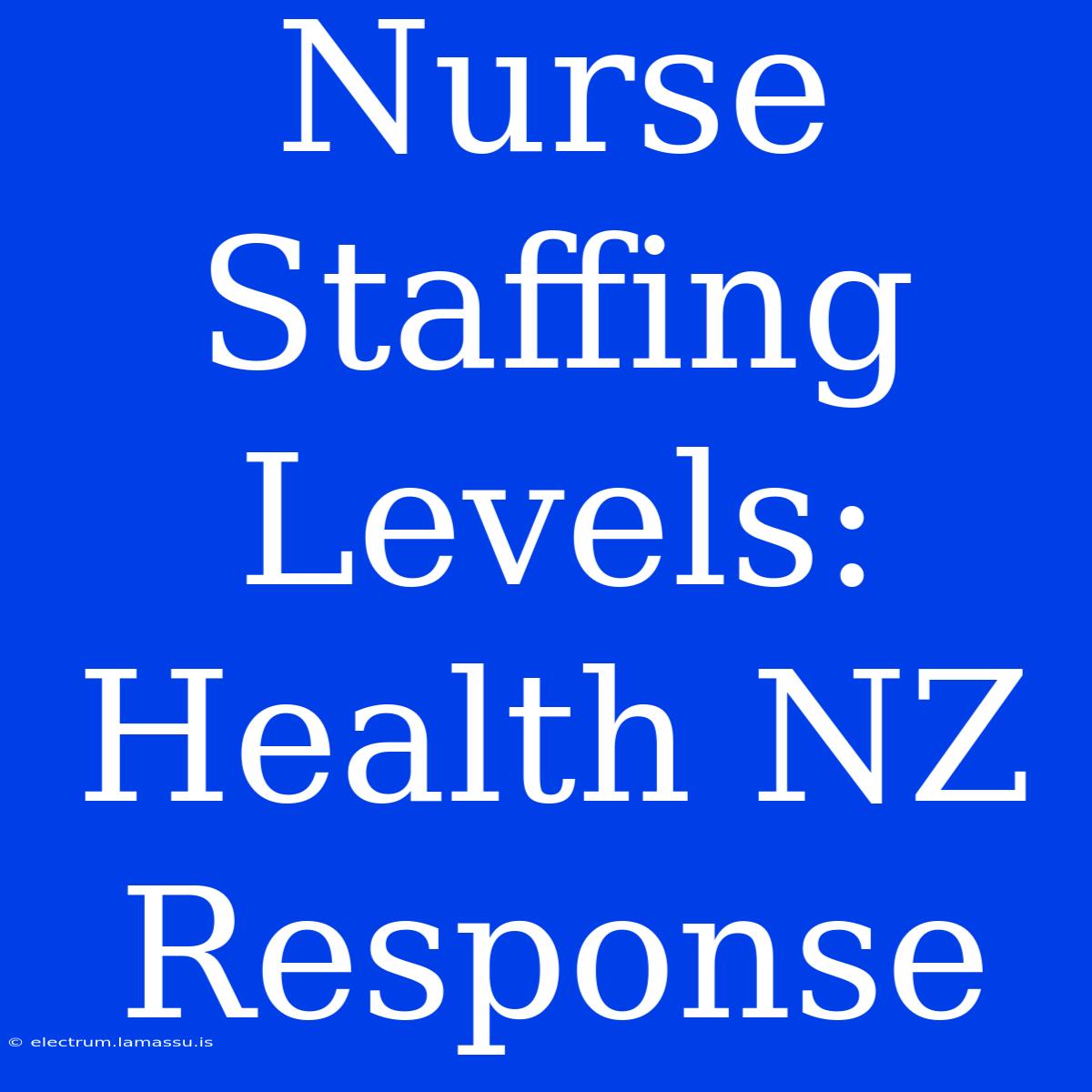Nurse Staffing Levels: Unpacking the Health NZ Response
Are nurse staffing levels adequate in New Zealand, and how is Health NZ responding to the critical need for a robust nursing workforce? This question has been at the forefront of healthcare discussions in the country, and the recent establishment of Health NZ has brought renewed focus on addressing the staffing shortage.
Editor Note: The establishment of Health NZ signifies a significant shift in healthcare governance, aiming to streamline and improve services. Understanding its approach to nurse staffing is paramount for patients, nurses, and stakeholders alike.
The importance of this topic lies in its direct impact on patient safety, quality of care, and the overall well-being of the nursing profession. This article delves into the complexities of nurse staffing levels in New Zealand, examining Health NZ's response, exploring key aspects, and providing insights into its potential effectiveness.
Analysis: We conducted an in-depth analysis of government reports, media coverage, and expert opinions to develop this comprehensive guide. This analysis provides a balanced perspective on the challenges and opportunities presented by Health NZ's approach to nurse staffing.
Key Takeaways
| Aspect | Description |
|---|---|
| Current Situation | New Zealand faces an ongoing shortage of nurses, particularly in rural and remote areas. High workload, burnout, and low wages exacerbate the issue. |
| Health NZ Goals | To create a sustainable and resilient nursing workforce through improved recruitment, training, and retention strategies. |
| Focus Areas | Health NZ is prioritizing increased wages, flexible working arrangements, and enhanced training programs to attract and retain nurses. |
| Challenges | Addressing the historical underfunding of the healthcare sector, competing with other countries for nurses, and tackling systemic issues within the nursing profession. |
Nurse Staffing Levels: Key Aspects
Recruitment and Retention:
- Increased Funding: Allocating greater financial resources to training and recruitment programs.
- Improved Working Conditions: Implementing initiatives to reduce workloads, promote flexible working arrangements, and address burnout.
- Competitive Salaries: Offering attractive salaries to attract and retain nurses.
Training and Development:
- Expansion of Nursing Schools: Increasing the number of nursing students to address the growing demand.
- Upskilling and Reskilling Programs: Providing opportunities for existing nurses to enhance their skills and knowledge.
- Rural and Remote Incentives: Offering financial and other incentives to encourage nurses to work in underserved areas.
Workforce Planning and Management:
- Data-Driven Approach: Utilizing data to analyze staffing needs and predict future demands.
- Collaborative Strategies: Engaging with stakeholders, including nurses' unions and professional organizations, to develop solutions.
- Technology Adoption: Utilizing technology to optimize scheduling, communication, and patient care delivery.
Exploring the Connection:
Increased Funding:
Introduction: Health NZ's commitment to increased funding is crucial for bolstering nurse staffing levels. This investment is critical to expanding training capacity, offering competitive salaries, and improving working conditions.
Facets:
- Roles: Increased funding allows for the establishment of new nursing schools and programs, supporting the growth of the nursing workforce.
- Examples: Investing in scholarships and tuition assistance for aspiring nurses.
- Impacts and Implications: Adequate funding can help attract and retain experienced nurses, mitigate burnout, and reduce the reliance on overseas recruitment.
Improved Working Conditions:
Introduction: Health NZ is focusing on improving working conditions to make nursing more appealing and sustainable. This involves addressing workload concerns, promoting flexibility, and addressing burnout.
Facets:
- Roles: Implementing strategies to reduce excessive workloads, provide better work-life balance, and foster a supportive work environment.
- Examples: Offering flexible scheduling options, investing in technology to streamline workflows, and providing access to mental health support services.
- Risks and Mitigations: Failure to address workload concerns could exacerbate burnout, leading to higher turnover rates.
FAQ
Introduction: Addressing common concerns and misconceptions related to nurse staffing levels.
Questions:
- Will Health NZ's efforts be enough to address the nursing shortage? While Health NZ's initiatives show promise, it is a complex challenge that requires sustained commitment and collaboration.
- What are the potential risks of relying heavily on overseas recruitment? Overdependence on overseas recruitment can lead to skill shortages in the countries of origin and may not address underlying systemic issues within the New Zealand healthcare system.
- How can patients ensure they are receiving adequate care with the current staffing levels? Patients are encouraged to voice their concerns with healthcare providers and advocate for their right to safe and effective care.
Summary: The success of Health NZ's response depends on its commitment to addressing the underlying causes of the nursing shortage and implementing sustainable solutions.
Tips for Nurses
Introduction: Advice for nurses navigating the current landscape.
Tips:
- Advocate for yourself and your colleagues. Participate in discussions about staffing levels and working conditions.
- Utilize available support resources. Seek mentorship, professional development opportunities, and mental health services.
- Stay informed about legislative changes and policy updates. Be aware of your rights and responsibilities within the healthcare system.
- Consider advocating for a legislative mandate for safe nurse-to-patient ratios. This can promote accountability and improve patient safety.
Summary: A Balanced Perspective
The establishment of Health NZ signifies a renewed focus on addressing the nurse staffing shortage in New Zealand. While challenges remain, the organization's commitment to increased funding, improved working conditions, and strategic workforce planning provides a glimmer of hope for a sustainable future. However, sustained effort, collaboration with stakeholders, and a commitment to addressing the root causes of the shortage are essential to ensure a strong and resilient nursing workforce.

